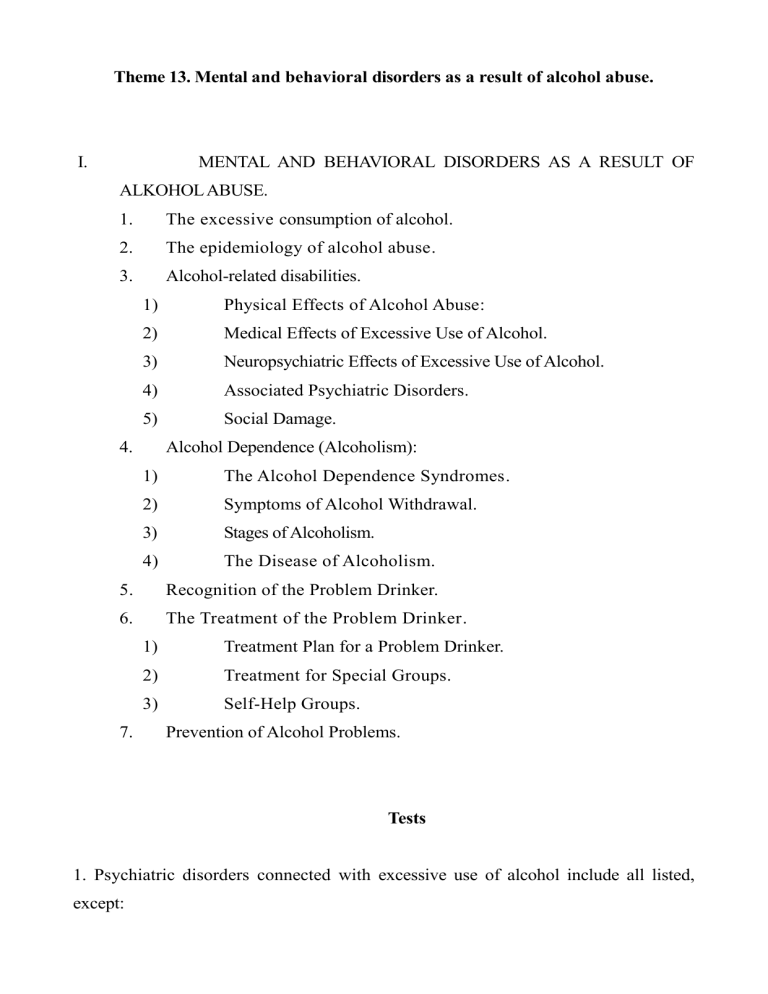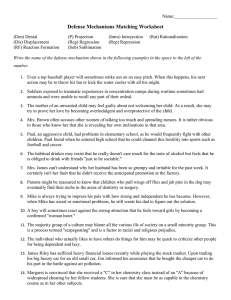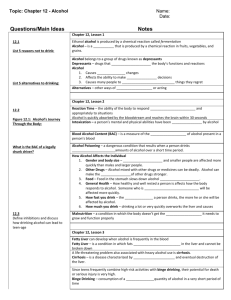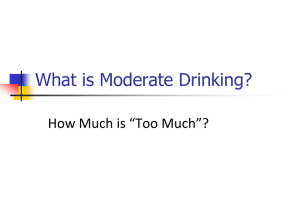20130328-150658

Theme 13. Mental and behavioral disorders as a result of alcohol abuse.
I.
MENTAL AND BEHAVIORAL DISORDERS AS A RESULT OF
ALKOHOL ABUSE.
1.
The excessive consumption of alcohol.
2.
The epidemiology of alcohol abuse.
3.
Alcohol-related disabilities.
1) Physical Effects of Alcohol Abuse:
2)
3)
Medical Effects of Excessive Use of Alcohol.
Neuropsychiatric Effects of Excessive Use of Alcohol.
4)
5)
Associated Psychiatric Disorders.
Social Damage.
4.
Alcohol Dependence (Alcoholism):
1) The Alcohol Dependence Syndromes.
2) Symptoms of Alcohol Withdrawal.
3) Stages of Alcoholism.
4) The Disease of Alcoholism.
5.
Recognition of the Problem Drinker.
6.
The Treatment of the Problem Drinker.
1)
2)
Treatment Plan for a Problem Drinker.
Treatment for Special Groups.
3) Self-Help Groups.
7.
Prevention of Alcohol Problems.
Tests
1. Psychiatric disorders connected with excessive use of alcohol include all listed, except:
a) personality change b) anxiety c) pseudohallucinations d) depressive disorder e) nothing listed
2. What is the characteristic of anxiety connected with excessive use of alcohol? a) occur rarely b) symptoms occur particularly during periods of partial withdrawal of alcohol c) symptoms occur particularly during periods of increase consumption of alcohol d) all listed e) nothing listed
3. Which of the symptoms are characteristic for encephalopathic stage of alcoholism? a) maximal tolerance towards alcohol, blackouts, situational drinking bouts, discomfort in the abstinent state, alcoholic psychoses b) decrease tolerance towards alcohol, decrease of stimulating effect, true drinking bouts, lack of quantitative and situational control c) increased tolerance towards alcohol, regular consumption, accentuation of personality d) decrease tolerance towards alcohol, blackouts, situational drinking bouts, absence of discomfort in the abstinent state, degradation of personality e) nothing listed
4. What is the characteristic for delirium caused by alcohol abuse? a) confused state of consciousness b) disorientation in time and place c) gross tremor of the hands d) hallucinations e) nothing listed
5. What is the first step in treatment of a drinker? a) drinker has make decision about withdrawal b) attainable goals should be set c) help the drinker to recognise the extent and seriousness of his problem d) patient should be involved in formulating the treatment plan e) nothing listed
6. Which drug is used most often to prevent delirium tremens or fits at the stage of withdrawal? a) Aminazine b) Diazepam c) Amitriptyline d) Pyracetam e) all listed
7. What is the characteristic of depressive disorders connected with excessive use of alcohol? a) slowing down of thinking and psychomotor retardation b) feelings of despair and guilt c) ideas of self-humiliation d) depressed patients sometimes drink excessively to relieve their symptoms e) nothing listed
8. Which of the symptoms are characteristic for addictive stage of alcoholism? a) maximal tolerance towards alcohol, blackouts, situational drinking bouts, discomfort in the abstinent state, alcoholic psychoses b) decrease tolerance towards alcohol, decrease of stimulating effect, true drinking bouts, lack of quantitative and situational control c) increased tolerance towards alcohol, regular consumption, accentuation of
personality d) maximal tolerance towards alcohol, blackouts, situational drinking bouts, absence of discomfort in the abstinent state, degradation of personality e) nothing listed
9. What is the earliest and commonest feature of alcohol withdrawal? a) nausea b) sweating c) hallucinations d) tremulousness e) nothing listed
10. What is the characteristic of hallucinations caused by alcohol delirium? a) true b) visual c) tactile d) involving images of animals e) all listed
11. The reduction of drinking to a safe level can be the appropriate goal for those who: a) has incurred serious physical consequences of drinking b) is in a job that carries a risk to others c) is pregnant d) drink excessively but are not dependent on alcohol e) nothing listed
12. What is the aim of psychological treatment of alcohol abuse? a) to prevent delirium tremens b) to prevent development of the amnesic syndrome
c) to relieve psychological problems that have led to alcohol abuse d) to sustain the patient's relatives e) nothing listed
Clinical task 1.
Patient A.K. male, 48 years old, was hospitalised in the state of severe alcoholic delirium. The psychotic state with consciousness disturbance lasted for 7 days, and after restoration of consciousness the patient didn't remember at all when and why he was hospitalised. His intelligence was comparatively intact, he was co-operative, so during the first month of his treatment he was often invited to speak to the students. Every time he was asked about the circumstances of entering the hospital his answers varied: he said that he came there "today" because he "had a cough" (or "pain in his back", or "stomach problems", etc.). His descriptions of "yesterday" varied too: he was "at a football game" (or
"stayed at home with his little daughter", or "went in his car to visit his parents"). He had no sense of time, and could not remember the way to his ward. He could never say, what he had for breakfast or lunch, or whether his relations came to see him today.
1. What symptoms does the patient have?
2. What psychopathological syndromes does the patient have?
3. What disease can you think of?
4. Prescribe treatment to the patient.
Clinical task 2.
Patient K., male 39 years old was brought to the psychiatric hospital by an ambulance.
Two days ago became anxious and restless. It seamed to him that his room was full of people, different voices shouted from outside through the wall that they were going to kill him, threatened him, suggested to go and have a drink. At night he couldn't sleep, saw
mice with their tails cut off, then a goblin appeared and ordered the patient to gather gold from the floor. He saw all these creatures and objects as if they were real, picked up golden coins and felt them in his hands. At the inpatient department the patient is excited, his state worsens in the evening and at night. The contact with him is formal.
Knows his name and age, but doesn't understand where he is.
1. What symptoms does the patient have?
2. What psychopathological syndromes does the patient have?
3. What disease can you think of?
4.
Prescribe treatment to the patient.
List of recommended literature
Basic literature.
1.
Concise Oxford Textbook of Psychiatry. M. Gelder, D. Gath, R.Mayou. –
Oxford; New York; Tokyo; Oxford University Press, 2007. – 953 p.
2.
Modern Synopsis of Psychiatry. A.M. Freedman, H.I. Kaplan, B.J. Sadock. –
USA, 1982. – 433 p.
3.
Psychiatric Dictionary / 5 th ed. R.J. Campbell. – Oxford; New York; Oxford
University Press, – 1981. – 693 p.
4.
Psychopatology and addictive Disorders / Ed. By Meyer. - New York; London,
1986. – 283 p.
5.
Psychiatry: course of lecture /Ed.by V.S. Bitensky. – Odessa, 2005. – 336 p.
6.
Zimbardo Ph.G. Psychology and Life. - USA, 19991. – 189 p.
Additional literature.
1.
Brundtland G.H. Mental health in the 21 st century // Bulletin of the World Helth
Organization. – 2000. - №87. – Р. 411.
2.
Desjarlais R., Eisenberg L., Good B. et al. World Mental Health: Problems and Priorities in Low-Income Countries. – New York: Oxford University Press,
1995. – 144 p.
3.
Marsella A., Kleinman A., Good B. Cross-cultural studies of depressive disorders. An overview. Culture and depression. – Berkley: University of
California Press, 1985. – 213 p.
4.
Mulrow C.D., Williams J.W. Jr., Trivedi M., et al. Treatment of depression: newer pharmacotherapies. Rockville, MD: Agency for Health Care Policy and
Research, 1999. – 253 р.
5.
Murray C.J.L., Lopez A.D. The global burden of disease: a comprehensive assessment of mortality and disability from disease, injuries and risk factors in
1990 and projected to 2020 .
Cambridge, MA: Harvard University Press, 1996. –
68 p.
6.
Kielholz P. Masked Depression. — Berne, 1973. – 97 p.
7.
Lopez-Ibor J. J. The Present Status of Psychotropic Drugs / Ed. by A. Cerletti,
F. J. Bove. - New York, 1999. - 519 p
8.
Preskorn, S.H. Outpatient management of depression: A guide for the Primarycare practitioner/ S.H. Preskorn. - Wichita; Kansas: Professional
Communications,Inc., 1994. - 147 p.
9.
Ustun T.B., Sartorius N. Mental Illness in General Health Care. An
International Study. – Chichester: John Willey @ Sons Ltd, 1995. – 336 p.








